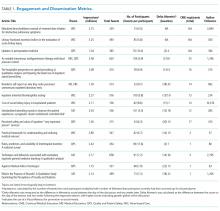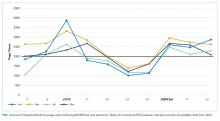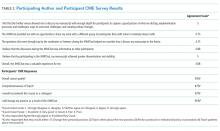The Adoption of an Online Journal Club to Improve Research Dissemination and Social Media Engagement Among Hospitalists
BACKGROUND: Twitter-based journal clubs are intended to connect clinicians, educators, and researchers to discuss recent research and aid in dissemination of results. The Journal of Hospital Medicine (JHM) began producing a Twitter-based journal club, #JHMChat, in 2015.
OBJECTIVE: To describe the implementation and assess the impact of a journal-sponsored, Twitter-based journal club on Twitter and journal metrics.
INTERVENTION: Each #JHMChat focused on a recently published JHM article, was moderated by a social media editor, and included one study author or guest.
MEASUREMENTS: The total number of participants, tweets, tweets/participant, impressions, page views, and change in the Altmetric score were assessed after each session. Thematic analysis of each article was conducted, and post-chat surveys of participating authors and participant responses to continuing medical education surveys were reviewed.
RESULTS: Seventeen Twitter-based chats were held: 7 (47%) focused on value, 6 (40%) targeted clinical issues, and 4 (27%) focused on education. On average, we found 2.17 (±0.583 SD) million impressions/session, 499 (±129 SD) total tweets/session, and 73 (±24 SD) participants/session. Value-based care articles had the greatest number of impressions (2.61 ± 0.55 million) and participants (90 ± 12). The mean increase in the Altmetric score was 14 points (±12), with medical education-themed articles garnering the greatest change (mean increase of 32). Page views were noted to have increased similarly to levels of electronic Table of Content releases. Authors and participants believed #JHMChat was a valuable experience and rated it highly on post-chat evaluations.
CONCLUSION: Online journal clubs appear to increase awareness and uptake of journal article results and are considered a useful tool by participants.
© 2018 Society of Hospital Medicine
RESULTS
Between October 2015 and November 2017, a total of 15 sessions were held with a mean of 2.17 (±0.583) million impressions/session, 499 (±129) total tweets/session, and 73 (±24) participants/session (compared to a range of 21-58 participants/session from other online journal clubs, where reported) with 7.2 (±2.0) tweets/participant (Table 1). The total number of participants for all sessions was 1096. Participating authors had on average 1389 (±2714) followers, ranging from a low of 37 to a high of 10,376 (Appendix). No correlation between author following and number of participants (r = 0.19), impressions (r = 0.05), or change in Altmetric score (r = 0.17) was seen.
Thematic analysis revealed 3 predominant themes among the chosen articles: Value-based care (VBC), Quality and Patient Safety (QPS), and Medical Education (ME). Articles focused on VBC had the greatest number of impressions (mean ±SD: 2.61 ± 0.55 million) and participants (mean ±SD: 90 ± 12), while QPS articles had the fewest impressions (mean ±SD: 1.71 ± 0.59 million) and number of participants (mean ±SD: 47 ± 16). The mean increase in the Altmetric score among all discussed articles was 14 (±12), from an average baseline of 30 (±37). Medical Education-themed articles appeared to garner the greatest increase in Altmetric scores, averaging an increase of 32 points, compared with an average baseline score of 31 (±32). In contrast, VBC and QPS articles averaged an increase of 8.6 and 8.4 points, from average baselines of 55 (±53) and 17 (±13), respectively. A 2-month analysis of JHM articles not included in these discussions, in which Altmetric scores were measured in the same way as those from the discussion, revealed a baseline Altmetric score of 27 (±24) with an average increase of 8 (±6) 2 weeks following the chat.
Four articles met the inclusion criteria for page view analysis and suggested that article page views increased to similar levels as the eTOC release (mean: 2668 vs. 2998, respectively; P = .35) (Figure). These increases equate to a 33% and 50% increase in average daily page views (2002) for the chat and eTOC release, respectively.
Ninety-three percent (14/15) of the participating authors responded to the post-discussion survey. All strongly agreed (5/5 on a Likert scale) that the venue allowed for an in-depth discussion about processes and challenges in conducting the study and allowed for greater dissemination and visibility of their work (5/5). Additionally, authors agreed that the journal club was a valuable experience for themselves (4.88/5) and other practitioners (4.88/5). Most agreed that the journal club allowed them to share their work with a different group of participants than usual (4.75/5) and that the experience changed how they would discuss their manuscripts in the future (4.75/5.0); Table 2).









